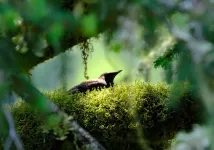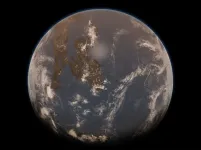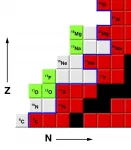A second look at sunlight
Researchers urge a closer examination of sunlight's efficacy in inactivating the SARS-CoV-2 virus
2021-03-30
(Press-News.org) A year ago scientists everywhere were scrambling to get their minds around the SARS-CoV-2, a novel coronavirus that caused the pandemic from which we are only now beginning to emerge. The world clung to every new development, every bit of science that could provide clues to managing life in the presence of this mysterious killer.
Many science-backed COVID-19 management concepts remain unchanged to this day: handwashing with soap and warm water disrupts the virus' lipid membrane. Social distancing can attenuate the virus's spread, ideally keeping it out of a host until it degrades. Other notions, such as droplet contact being the primary mode of transmission, were modified when emerging evidence showed that under certain conditions, the virus could remain suspended in air for extended periods of time.
In a letter(link is external) in the Journal of Infectious Diseases, a team of researchers from UC Santa Barbara, Oregon State University, University of Manchester and ETH Zurich examines another of SARS-CoV-2's well known characteristics -- its vulnerability to sunlight. Their conclusion? It might take more than UV-B rays to explain sunlight inactivation of SARS-CoV-2.
The idea that an additional mechanism might be in play came when the team compared data from a July 2020 study(link is external) that reported rapid sunlight inactivation of SARS-CoV-2 in a lab setting, with a theory(link is external) of coronavirus inactivation by solar radiation that was published just a month earlier.
"The theory assumes that inactivation works by having UV-B hit the RNA of the virus, damaging it," said UC Santa Barbara mechanical engineering professor and lead author Paolo Luzzatto-Fegiz(link is external). Judging from the discrepancies between the experimental results and the predictions of the theoretical model, however, the research team felt that RNA inactivation by UV-B "might not be the whole story."
According to the letter, the experiments demonstrated virus inactivation times of about 10-20 minutes -- much faster than predicted by the theory.
"The theory predicts that inactivation should happen an order of magnitude slower," Luzzatto-Fegiz said. In the experiments, viruses in simulated saliva and exposed to UV-B lamps were inactivated more than eight times faster than would have been predicted by the theory, while those cultured in a complete growth medium before exposure to UV-B were inactivated more than three times faster than expected. To make the math of the theory fit the data, according to the letter, SARS-CoV-2 would have to exceed the highest UV-B sensitivity of any currently known virus.
Or, Luzzato-Fegiz and colleagues reasoned, there could be another mechanism at play aside from RNA inactivation by UV-B rays. For instance, UV-A, another, less energetic component of sunlight might be playing a more active role than previously thought.
"People think of UV-A as not having much of an effect, but it might be interacting with some of the molecules in the medium," he said. Those reactive intermediate molecules in turn could be interacting with the virus, hastening inactivation. It's a concept familiar to those who work in wastewater treatment and other environmental science fields.
"So, scientists don't yet know what's going on," Luzzatto-Fegiz said; "Our analysis points to the need for additional experiments to separately test the effects of specific light wavelengths and medium composition."
Results of such experiments might provide clues into new ways of managing the virus with widely available and accessible UV-A and UV-B radiation. While UV-C radiation is proved effective against SARS-CoV-2, this wavelength does not reach the earth's surface and must be manufactured. Although UV-C is presently used in air filtration and in other settings, its short wavelengths and high energy also makes UV-C the most damaging form of UV radiation, limiting its practical application and raising other safety concerns.
"UV-C is great for hospitals," said co-author Julie McMurry. "But in other environments -- for instance kitchens or subways -- UV-C would interact with the particulates to produce harmful ozone." While no single intervention will eliminate risk, this research would provide one further tool to reduce exposure, thus slowing transmission and improving health outcomes.
Co-author and UCSB mechanical engineering professor Yangying Zhu(link is external) added that UV-A turning out to be capable of inactivating the virus could be very advantageous: there are now widely available inexpensive LED bulbs that are many times stronger than natural sunlight, which could accelerate inactivation times. UV-A could potentially be used far more broadly to augment air filtration systems at relatively low risk for human health, especially in high-risk settings such as hospitals and public transportation, but the specifics of each setting warrant consideration, said co-author Fernando Temprano-Coleto.
INFORMATION:
Research in this paper was conducted also by François J. Peaudecerf at ETH Zurich and Julien Landel at University of Manchester.
ELSE PRESS RELEASES FROM THIS DATE:
2021-03-30
Not all species may travel the same path to existence, at least according to new findings from the University of Colorado Boulder and collaborators.
This new research, out now in Science, looked at a newly discovered, endangered songbird located only in South America--the Iberá Seedeater--and found that this bird followed a very rare evolutionary path to come into existence at a much faster pace than the grand majority of species.
By comparing this bird to a closely related neighbor (the Tawny-Bellied Seedeater) in the same group (the southern capuchino seedeaters), the researchers determined that genetic shuffling of existing variations, rather than new random mutations, brought this species into existence--and their ...
2021-03-30
CORVALLIS, Ore. - Oregon State University researchers broadcast marbled murrelet calls in mature forests and found that the threatened seabirds' choice of breeding locations is strongly influenced by whether they hear other murrelets in the area.
The research by scientists in the OSU College of Forestry and College of Agricultural Sciences is important because the elusive seabird's populations are in decline and recovery may be hindered by there being too few birds around to provide information to each other about where to nest.
Findings were published in Ornithology, the the flagship journal of the American Ornithologists Union.
"The odds that marbled murrelets would ...
2021-03-30
On sultry summer afternoons, heating, ventilation and air conditioning (HVAC) systems provide much-needed relief from the harsh heat and humidity. These systems, which often come with dehumidifiers, are currently not energy efficient, guzzling around 76% of the electricity in commercial and residential buildings.
In a new study, Texas A&M University researchers have described an organic material, called polyimides, that uses less energy to dry air. Furthermore, the researchers said polyimide-based dehumidifiers can bring down the price of HVAC systems, which currently cost thousands of dollars.
"In this study, we took an existing and rather robust polymer and then improved its dehumidification efficiency," said Hae-Kwon Jeong, McFerrin Professor in the Artie McFerrin ...
2021-03-30
Since early in the COVID-19 pandemic, parents, teachers, and school administrators have faced difficult questions regarding when and how to safely reopen for in-person learning. During the 2020-2021 fall semester, school districts around the United States navigated their reopening plans -- many opting for exclusively online learning or hybrid models -- with little data on how SARS-CoV-2 spreads among children or how in-person learning would impact transmission in the schools' communities. A new study in The Journal of School Health joins a growing body of evidence that, with appropriate measures, there are ways for schools to safely reopen.
In this study, scientists analyzed data from two large, independent k-12 schools that re-opened for in-person learning ...
2021-03-30
WASHINGTON--A vast global ocean may have covered early Earth during the early Archean eon, 4 to 3.2 billion years ago, a side effect of having a hotter mantle than today, according to new research.
The new findings challenge earlier assumptions that the size of the Earth's global ocean has remained constant over time and offer clues to how its size may have changed throughout geologic time, according to the study's authors.
Most of Earth's surface water exists in the oceans. But there is a second reservoir of water deep in Earth's interior, in the form of hydrogen and oxygen attached to minerals in the mantle.
A new study in AGU Advances, which publishes high-impact, open-access research and commentary across the Earth and space sciences, estimates how much water ...
2021-03-30
A researcher from Skoltech and his German colleagues have developed a neural network-based classification algorithm that can use data from an apple orchard to predict how well apples will fare in long-term storage. The paper was published in Computers and Electronics in Agriculture.
Before the fruit and vegetables we all like end up on our tables, they have to be stored for quite some time, and during this time they can develop physiological disorders such as flesh browning or superficial scald (brown or black patches on the skin of the fruit). These disorders contribute to the loss of a substantial amount ...
2021-03-30
Some 8,300 million metric tons of plastics have been manufactured since production exploded in the 1950s, with more than 75 percent ending up as waste and 15 million metric tons reaching oceans every year. Plastic waste fragments into increasingly smaller but environmentally persistent "microplastics," with potentially harmful effects on the health of people, wildlife and ecosystems. A new collection, "Confronting Plastic Pollution to Protect Environmental and Public Health," is publishing on March 30th, 2021 in the open access journal PLOS Biology that addresses critical scientific challenges in understanding the impacts of microplastics.
The collection features three evidence-based commentaries from ecotoxicology and environmental health ...
2021-03-30
RESTON, Va. - Greater sage-grouse populations have declined significantly over the last six decades, with an 80% rangewide decline since 1965 and a nearly 40% decline since 2002, according to a new report by the U.S. Geological Survey. Although the overall trend clearly shows continued population declines over the entire range of the species, rates of change do vary regionally.
The report represents the most comprehensive analysis of greater sage-grouse population trends ever produced and lays out a monitoring framework to assess those trends moving forward. The study can also be used to evaluate the effectiveness of greater sage-grouse conservation efforts and analyze factors that contribute to habitat loss and population change -- all critical ...
2021-03-30
(Philadelphia, PA) - The human heart works under high demand, constantly pumping oxygen-rich blood through the body. When faced with disease, however, fulfilling this demand can become increasingly difficult and harmful. In the case of chronic high blood pressure - a leading cardiovascular disease in the United States - the heart continuously overexerts, resulting in maladaptive growth and, ultimately, severe dysfunction of the heart muscle itself.
Maladaptive growth of the heart, known as cardiac hypertrophy, is brought about in part by activation of G protein-coupled kinase ...
2021-03-30
Researchers at Washington University in St. Louis reported the first observations of a new form of fluorine, the isotope 13F, described in the journal Physical Review Letters.
They made their discovery as part of an experiment conducted at the National Superconducting Cyclotron Laboratory at Michigan State University (MSU).
Fluorine is the most chemically reactive element on the periodic table. Only one isotope of fluorine occurs naturally, the stable isotope 19F. The new isotope, 13F, is four neutrons removed from the proton drip line, the boundary that delimits the zone beyond which atomic nuclei decay by the emission ...
LAST 30 PRESS RELEASES:
[Press-News.org] A second look at sunlight
Researchers urge a closer examination of sunlight's efficacy in inactivating the SARS-CoV-2 virus




